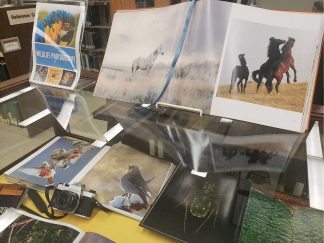By Kristen Mastel, Justin Boeser, and Shannon Farrell

Natural Resources Library exhibit on wildlife photography. Exhibit design by Amy Gmur. Photo by Justin Boeser.
Wednesday, June 15, is Nature Photography Day. In celebration of the day, and to encourage students and staff to get outdoors and capture what they see on campus and during summer break, the Natural Resources Library has an exhibit on wildlife photography.
Did you know that the Natural Resources Library, Magrath Library, and Andersen Horticultural Library have nice collections of books on wildlife and nature photography, featuring plants and animals from here in Minnesota and around the world? Try searching “wildlife photography” or “nature photography” and native species.
We encourage you to get outside, whether in your backyard or a local park, and explore nature’s beauty this summer. Here are a few tips to get you started with nature photography.
- Use the rule of thirds. Imagine a 3×3 grid over the image you want to capture. The grid should divide the image into nine sections with two equal vertical lines and two equal horizontal lines. Try to place your photo’s subject where any two of these imaginary lines would intersect. This creates a compositionally interesting and engaging photo. The camera in your phone may even have the option to add a grid!
- Utilize natural light from the sun instead of using your camera’s flash or other light source during daytime shooting. Pay attention to subtle changes in the light, such as a little break in the clouds or going out during the “golden hour” before sunset.
- Use a tripod. Consider bringing a tripod to steady your camera, or look to nature to steady your hand with a rock, fence, or other object. You can also try kneeling, pulling your elbows in tight, or even lying on your stomach for close-up shots of something on the ground.
- Observe nature. If you are looking for a specific bird or plant, do a little research and find out where it likes to hang out. Does the bird like the edges of the forest or does it prefer being high up in a tree? If looking for a specific plant or animal, try Seek or iNaturalist to locate specific spottings, or to see what has been spotted close to your location? For birds, also try apps like Merlin, to learn what their songs are to help direct you where to look. If you are looking for reptiles or amphibians, Herp Mapper has a great website on which users can pin locations of the animals they’ve spotted. There is also a wide variety of books at the library that will help you locate and identify all kinds of flora and fauna!
- Be patient. Animals can scare easily. Settle into a spot for a good 20 minutes and nature will get used to you and not think you are a threat. Be patient and observant; Joel Sartore of National Geographic sometimes waits days for the perfect shot! For inspiration, you can see his beautiful photography at The Natural Resources Library in his book “The Photo Ark.”
- Respect nature. Just as with camping, remember to pack in and pack out. Take everything with you when you leave a site, and possibly leave it better than before by picking up trash or removing invasive plant species.
- Plan. Dress according to the weather you may encounter in the season and bring extra provisions. Bring a friend, let someone know your outdoor plans, or even share your location with someone that you trust. Don’t forget it is now tick season in Minnesota, so consider wearing long pants and tucking them into your socks.
Campus location tips
Looking for some places to photograph on campus? Here are a few suggestions:
- University Minnesota Landscape Arboretum: You can’t go wrong exploring the hundreds of acres where every day something new is blooming. Check out the Andersen Horticultural Library while you are visiting for terrific examples of art focused on nature.
- Bell Museum: Try photographing the animal sculptures that are set in native landscapes.
- Horticultural Display and Trial Garden: Check out this educational garden that always has interesting trials and tests going on as student projects.
- Sarita Wetlands: Tucked behind the facilities plant on the St. Paul campus, the wetlands can be teeming with migrant birds and butterflies.
- The banks of Mississippi River: The East and West Bank of campus is separated by the Mississippi River, and it always is a great spot to photograph bald eagles and more!




